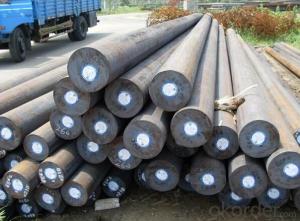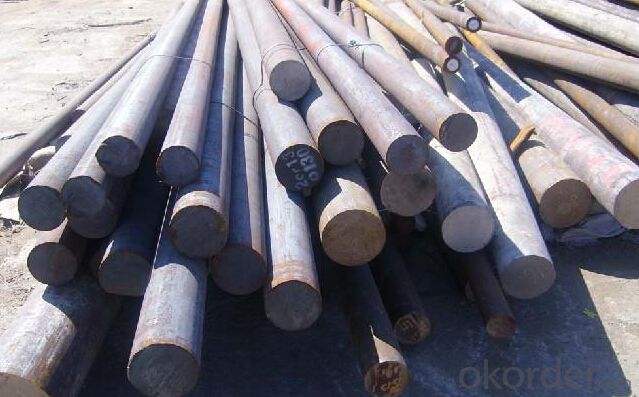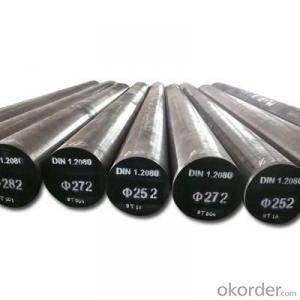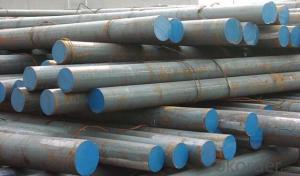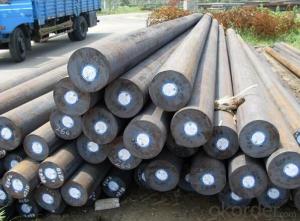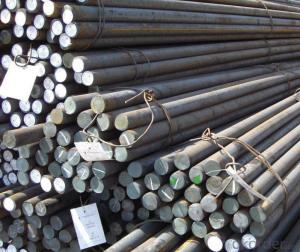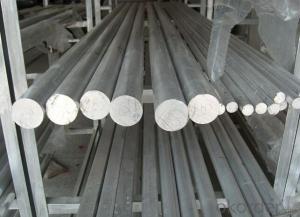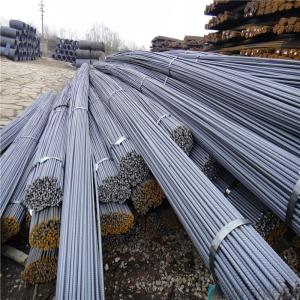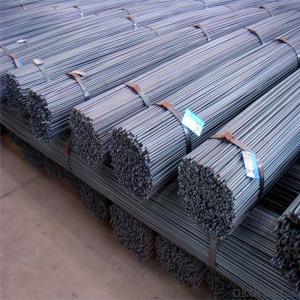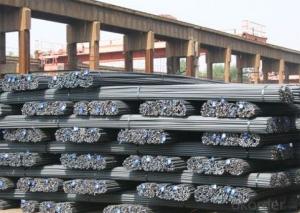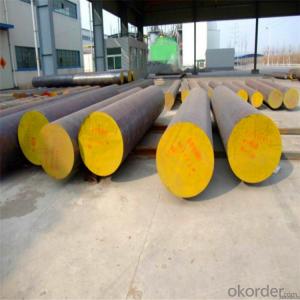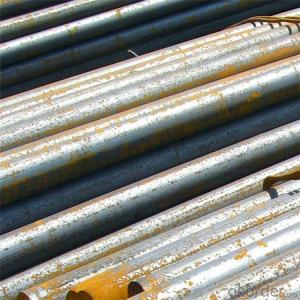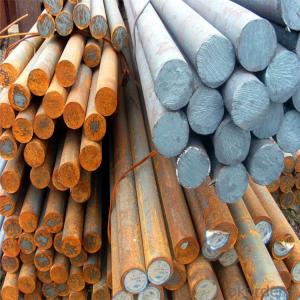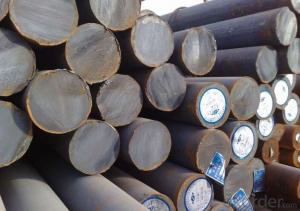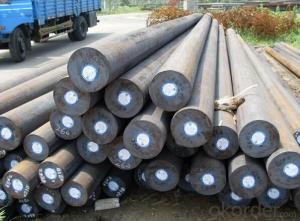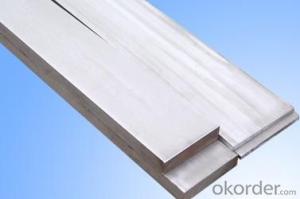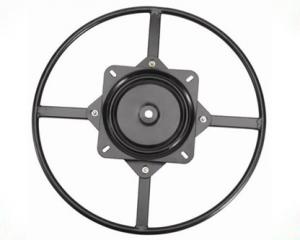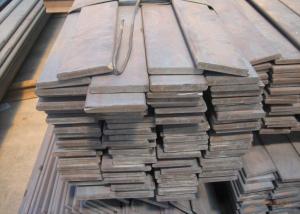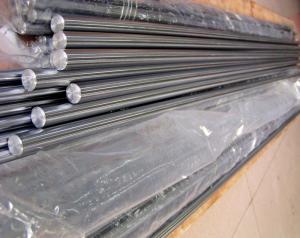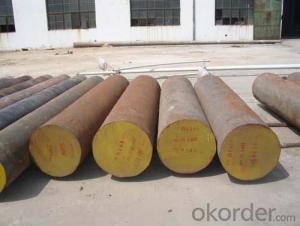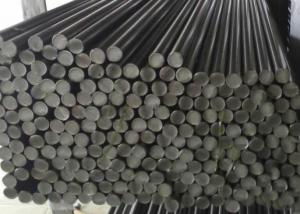Large Stock Grade S45C Mild steel round Bar Sizes
- Loading Port:
- Shanghai
- Payment Terms:
- TT OR LC
- Min Order Qty:
- 3 m.t.
- Supply Capability:
- 100000 m.t./month
OKorder Service Pledge
OKorder Financial Service
You Might Also Like
Specification
Large Stock Grade S45C Mild steel round Bar Sizes
Details Information of Large Stock Grade S45C Mild steel round Bar Sizes
| Name | SAE1045 Carbon Steel Round Bar |
| Shape | Round Bar/Square Bar/Flat Bar/Plate/Wire |
| Standard | GB/ASTM/SAE/AISI/DIN/JIS/EN/BS |
| Surface Treatment: | Black/Peeling/Polished/Machined |
| Delivery Condition: | Hot Rolled or Forged/Peeled or Black Surface |
| Test | SGS/UT 100% Elements Testing |
| Certificate: | ISO/Mill Certificate |
| Service: | 24 hours online service / |
| more than 20 years trading and manufacture | |
| Quality Assurance: | the third party inspection, such as SGS, BV, TUV…etc. is acceptable |
| Packaging Details: | Seaworthy Packaging or as per customer's packing instruction |
| Carbon structure round bar | Q195 Q235A Q235B 10# 20#-55# S45CB |
| Low alloy high strength round bar | Q345A/Q345C/Q345D Q345B Q345E |
| Alloy structure round bar | SAE51B20 20Cr 40Cr 40CrV 20CrMo/30CrMo/35CrMo/42CrMo 20CrMoA/30CrMoA/35CrMoA/42CrMoA/42Cr ML20CrMo/ML30CrMo/ML35CrMo/ML42CrMo B7/SCM435-440 20MnTiB 20CrMnMo 20CrMoH 42CrMoH 40MnB/40MnBH 30Mn2-40Mn2 27SiMn 50CrVA 30CrMnTi |
| Pinion steel | 20CrMnTi 20CrMnTiH 20CrMnTiHCS/20CrMnTiHLD Q20CrMnTi-1/Q20CrMnTi-2 |
| Sucker rod | 20-35CrMoA |
| Free-cutting steel | GT1215S |
| Spring steel | 60Si2MnA 65Mn |
| Ball bearing steel | GCr15 |
Chemical Composition of Large Stock Grade S45C Mild steel round Bar Sizes
| C | Si | Mn | P | S | Cr | Ni | Cu |
| 0.17-0.24 | 0.17-0.37 | 0.35-0.65 | ≤0.035 | ≤0.035 | ≤0.25 | ≤0.25 | ≤0.25 |
| Tensile strength (σb/MPa) | Yield strength (σb/MPa) | Elongation (δ5/%) |
| ≥410(42) | ≥245(25) | ≥25 |
Company Introduction of Large Stock Grade S45C Mild steel round Bar Sizes
CNBM International Corporation is the most import and export platform of CNBM group(China National Building Material Group Corporation) ,which is a state-owned enterprise, ranked in 270th of Fortune Global 500 in 2015.
With its advantages, CNBM International are mainly concentrate on Cement, Glass, Iron and Steel, Ceramics industries and devotes herself for supplying high quality series of refractories as well as technical consultancies and logistics solution.
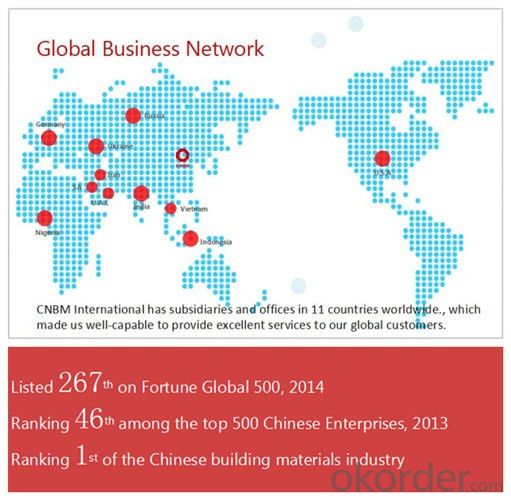
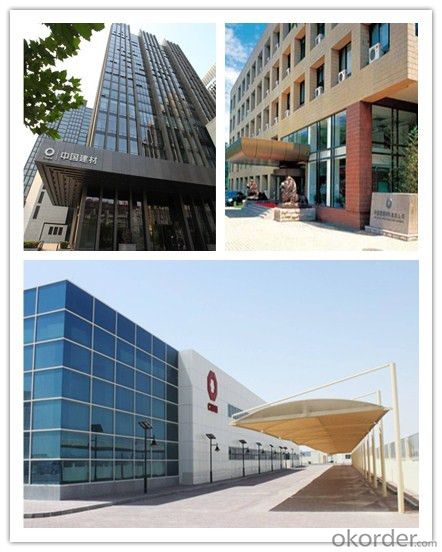
Certificates of Large Stock Grade S45C Mild steel round Bar Sizes
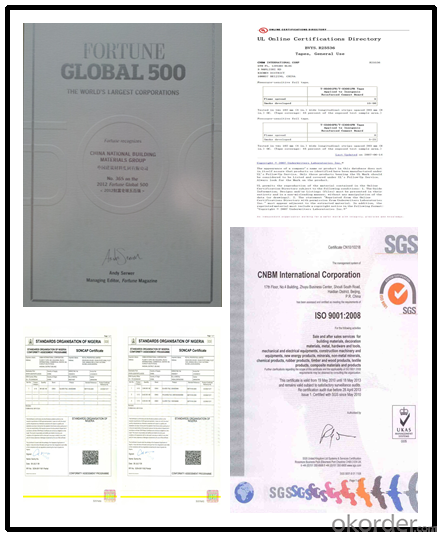
Packaging & Delivery of Large Stock Grade S45C Mild steel round Bar Sizes
Packaging Detail | Sea worthy packing /as per customer's packing instruction |
Delivery Detail | 15 ~ 40 days after receiving the deposit |
Products show of Large Stock Grade S45C Mild steel round Bar Sizes
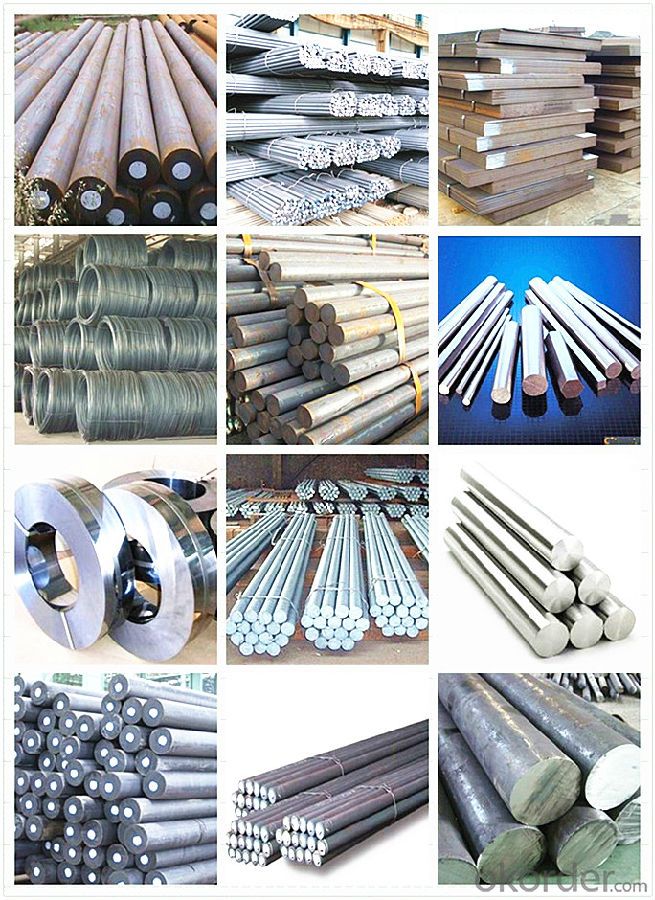
FAQ
Are you a trading company or manufacturer? | Manufacturer |
What’s the MOQ? | 3 metric ton |
What’s your delivery time? | 15-35 days after downpayment received |
Do you Accept OEM service? | Yes |
what’s your delivery terms? | FOB/CFR/CIF |
What's the Payment Terms? | 30% as deposit,70% before shipment by T/T |
Western Union acceptable for small amount. | |
L/C acceptable for large amount. | |
Scrow ,Paybal,Alipay are also ok | |
Why choose us? | Chose happens because of quality, then price, We can give you both. Additionally, we can also offer professional products inquiry, products knowledge train (for agents), smooth goods delivery, excellent customer solution proposals. |
What's your available port of Shipment? | Main Port, China |
What’s your featured services? | Our service formula: good quality+ good price+ good service=customer's trust
|
Where are your Market? | Covering more than 160 countries in the world |
- Q: How does special steel perform in high-pressure environments?
- Special steel performs exceptionally well in high-pressure environments due to its superior strength, durability, and resistance to corrosion. Its unique composition and advanced manufacturing processes enable it to withstand extreme pressures, preventing deformation and maintaining structural integrity. Additionally, special steel's high tensile strength allows it to handle the immense stress and pressure without compromising its performance or safety.
- Q: How does special steel perform under high-temperature oxidation?
- Special steel is engineered to exhibit outstanding performance when exposed to high temperatures, particularly in terms of oxidation. It is fabricated utilizing alloys that possess a significant quantity of chromium, which generates a shielding chromium oxide layer on the steel's surface once confronted with elevated temperatures. This chromium oxide layer acts as a barrier, thwarting further oxidation and safeguarding the steel against corrosion. The generous amount of chromium present in special steel also heightens its resistance to scaling, which refers to the development of thick layers of oxide on the steel's surface. Scaling can compromise the steel's integrity and result in failure when subjected to high temperatures. Nonetheless, special steel retains its structural soundness even at elevated temperatures due to its capacity to resist scaling. Apart from chromium, special steel may contain additional alloying elements like nickel, molybdenum, and vanadium. These elements contribute to the steel's resistance to high-temperature oxidation by further augmenting the formation and stability of the protective oxide layer. Overall, special steel exhibits exceptional performance under high-temperature oxidation circumstances. Its distinctive composition and alloying elements enable it to establish a protective oxide layer, resist scaling, and retain its strength and integrity even at elevated temperatures. As a result, it is extensively utilized in various industries that involve high-temperature applications, including power generation, aerospace, and petrochemical industries.
- Q: What are the requirements for special steel used in low-temperature applications?
- To ensure optimal performance and reliability in low-temperature applications, special steel must fulfill specific criteria. These criteria primarily encompass three crucial factors: toughness, resistance to brittle fracture, and corrosion resistance. Toughness plays a paramount role in low-temperature applications as it determines a material's capacity to absorb energy and withstand cracking or fracturing. High toughness is essential in special steel designed for low-temperature environments, which is typically achieved through the addition of specific alloying elements like nickel and manganese. These elements enhance the steel's ability to endure impact loads and prevent catastrophic failures. Another vital requirement for steel used in low-temperature settings is resistance to brittle fracture. At low temperatures, steel becomes more prone to brittle fracture, which can occur suddenly without any significant deformation or warning signs. To mitigate this risk, special steel for low-temperature applications undergoes specific heat treatment processes to refine its microstructure and enhance its resistance to brittle fracture. Corrosion resistance also plays a crucial role in special steel intended for low-temperature applications. Low temperatures often lead to the formation of ice or condensation, which can introduce moisture and potentially corrosive substances to the steel's surface. Therefore, the steel must possess exceptional corrosion resistance properties to prevent degradation and maintain its structural integrity over time. This is typically achieved by incorporating corrosion-resistant elements such as chromium and molybdenum. In addition to these primary requirements, other factors like dimensional stability, weldability, and cost-effectiveness should also be taken into consideration when selecting special steel for low-temperature applications. The material should exhibit good dimensional stability to retain its shape and mechanical properties under varying temperature conditions. It should also be easily weldable to facilitate construction and maintenance processes. Furthermore, the chosen steel should strike a balance between performance and the overall project budget, ensuring cost-effectiveness. In conclusion, special steel used in low-temperature applications must possess high toughness, resistance to brittle fracture, and corrosion resistance. Meeting these requirements guarantees the steel's reliability and longevity in demanding low-temperature environments, enabling safe and efficient operations in various industries such as cryogenic storage, oil and gas exploration, and transportation.
- Q: How does special steel compare to other materials?
- Special steel, known as alloy steel as well, possesses outstanding strength, durability, and resistance to wear and corrosion. When compared to regular steel, aluminum, and plastic, special steel stands out due to its superior mechanical properties. To begin with, special steel offers higher tensile strength and hardness, making it perfect for applications that require heavy-duty performance. Its ability to withstand high pressures and temperatures, as well as resistance to deformation, make it suitable for industries like aerospace, automotive, and construction. Furthermore, special steel has excellent wear resistance, making it suitable for applications that endure friction, abrasion, and impact. This characteristic reduces the need for frequent repairs or replacements, resulting in cost savings and improved efficiency. When it comes to corrosion resistance, special steel surpasses regular steel, which tends to rust when exposed to moisture or aggressive environments. The presence of elements like chromium, nickel, and molybdenum in its composition creates a protective layer on the surface, preventing corrosion and extending the lifespan of the material. Compared to materials like aluminum and plastic, special steel has the advantage of being more robust and less prone to deformation or breakage. While aluminum is lightweight, it lacks the strength and hardness of special steel, limiting its suitability for heavy-duty applications. On the other hand, plastic offers lower strength and durability compared to special steel, making it less appropriate for demanding tasks. Moreover, special steel can be easily machined, fabricated, and welded, allowing for versatile applications across various industries. Its flexibility in terms of shaping and forming makes it the preferred choice in the manufacturing of components and structures. In conclusion, special steel outperforms other materials in terms of strength, durability, wear resistance, corrosion resistance, and versatility. Its exceptional properties make it an essential material in demanding industries where reliability and performance are of utmost importance.
- Q: What are the different electrical grades of special steel?
- There are several electrical grades of special steel that are specifically designed to have superior electrical properties. These grades include: 1. Electrical Silicon Steel: This grade of special steel contains a high percentage of silicon, typically around 3-4%. The presence of silicon helps to minimize eddy current losses and improve the magnetic properties of the steel, making it ideal for use in electrical transformers and motors. 2. Electrical Stainless Steel: This grade of special steel is made from stainless steel alloys, which are known for their excellent corrosion resistance. The electrical stainless steel has a low electrical resistivity and high thermal conductivity, making it suitable for electrical connectors, terminals, and other components that require good electrical conductivity and resistance to oxidation. 3. Electrical Tool Steel: Tool steels are commonly used in the manufacturing of various tools and dies. Some tool steels are specifically formulated to have improved electrical properties, including high electrical conductivity and resistance to heat. These grades are often used in the production of electrical contacts, switches, and other electrical components that require high wear resistance and good electrical performance. 4. Electrical Copper-Clad Steel: This grade of special steel is made by bonding a layer of copper to a steel core. The copper layer provides excellent electrical conductivity, while the steel core provides strength and durability. Electrical copper-clad steel is commonly used in applications where high electrical conductivity is required, such as in power transmission lines and grounding systems. Overall, the different electrical grades of special steel offer a range of electrical properties to meet the specific needs of various electrical applications. These grades are carefully engineered to provide optimal electrical performance, durability, and resistance to corrosion and wear.
- Q: What are the common defects found in special steel?
- Some common defects found in special steel include surface defects such as scratches, pitting, and scaling, as well as internal defects like cracks, voids, and inclusions. These defects can negatively impact the mechanical properties and performance of the steel, compromising its strength, durability, and corrosion resistance.
- Q: What are the different nuclear grades of special steel?
- Special steel grades with different nuclear classifications are utilized in the nuclear industry to adhere to strict safety, reliability, and performance standards. These grades are engineered to endure the challenging conditions present in nuclear power plants and other nuclear facilities. There exist various nuclear grades of special steel, each possessing distinct characteristics and applications. Some commonly utilized grades include: 1. 304/304L stainless steel: This grade boasts exceptional resistance to corrosion and high strength at elevated temperatures, making it widely employed in nuclear applications. It finds use in the fabrication of reactor vessels, heat exchangers, and piping systems. 2. 316/316L stainless steel: Similar to 304/304L, this grade offers superior resistance to corrosion and high creep strength. It is commonly employed in the construction of components exposed to corrosive environments, such as coolant systems, steam generators, and fuel handling equipment. 3. 321 stainless steel: This grade contains titanium, which stabilizes the steel during welding to prevent sensitization. It frequently finds application in nuclear scenarios involving welding, such as piping systems and pressure vessels. 4. Duplex stainless steels: These grades, including 2205 and 2507, combine high strength with excellent corrosion resistance. They are frequently employed in nuclear applications that involve highly corrosive environments, such as seawater-cooled systems and containment structures. 5. Low alloy steels: These steels, such as A533B and A508, are used in the construction of reactor pressure vessels due to their exceptional strength and toughness. These grades are specifically designed to withstand the extreme conditions within a nuclear reactor. It is crucial to consider specific factors such as temperature, pressure, corrosion resistance, and mechanical properties when selecting the appropriate nuclear grade of special steel for a given application. Rigorous testing and quality control measures are implemented to ensure the suitability of these grades for use in the nuclear industry.
- Q: What are the advantages of using special steel?
- There are several advantages of using special steel. Firstly, it has superior strength and durability compared to regular steel, making it suitable for demanding applications and harsh environments. Special steel also offers excellent resistance to corrosion, heat, and wear, increasing its lifespan and reducing maintenance costs. Additionally, its unique properties enable manufacturers to create complex and intricate designs, resulting in more efficient and lightweight products. Overall, special steel provides enhanced performance, longevity, and versatility, making it a preferred choice in various industries.
- Q: What are the specific requirements for special steel used in the defense sector?
- Due to the critical nature of its applications, the defense sector imposes highly demanding requirements on special steel. These requirements encompass: 1. Exceptional strength and durability: Special steel utilized in the defense sector must possess outstanding strength and durability to withstand extreme conditions and endure wear and tear. It should have the capacity to endure high levels of stress, impact, and pressure. 2. Superior corrosion resistance: Defense equipment frequently operates in harsh environments and is exposed to elements that can cause corrosion. Consequently, special steel employed in the defense sector must display excellent corrosion resistance properties to ensure the equipment's longevity and reliability. 3. Heat resistance: Defense applications often involve exposure to high temperatures, such as in jet engines or armored vehicle components. Special steel used in these sectors must retain its strength and structural integrity even at elevated temperatures. 4. Machinability and weldability: Special steel employed in the defense sector should possess favorable machinability and weldability characteristics to facilitate manufacturing and assembly processes. This allows for ease of fabrication, repair, and maintenance of defense equipment. 5. Hardness and toughness: Defense applications necessitate a combination of hardness and toughness in special steel. It must resist penetration and deformation while simultaneously being able to absorb energy and resist fracture. 6. Non-magnetic properties: In specific defense applications, such as submarines and magnetic resonance imaging (MRI) equipment, non-magnetic properties are essential. Special steel employed in these sectors must possess low magnetic permeability to prevent interference with sensitive electronic systems. 7. Certification and compliance: Special steel used in the defense sector must meet specific certification and compliance standards, such as those established by defense organizations or international quality management systems like ISO 9001. These standards guarantee the quality, traceability, and reliability of the steel. Meeting these specific requirements for special steel utilized in the defense sector is crucial to ensure the safety, effectiveness, and longevity of defense equipment and systems. Rigorous testing and quality control processes are implemented to ensure that the steel meets the required specifications and standards.
- Q: What are the properties of low alloy steel?
- Low alloy steel is characterized by its composition, which contains a smaller amount of alloying elements compared to other types of steel. These alloys typically include elements such as nickel, chromium, molybdenum, and vanadium. The properties of low alloy steel include increased strength, improved toughness and hardenability, better corrosion resistance, and enhanced wear resistance. Additionally, low alloy steel offers excellent weldability and malleability, making it suitable for various applications in industries such as automotive, construction, and manufacturing.
Send your message to us
Large Stock Grade S45C Mild steel round Bar Sizes
- Loading Port:
- Shanghai
- Payment Terms:
- TT OR LC
- Min Order Qty:
- 3 m.t.
- Supply Capability:
- 100000 m.t./month
OKorder Service Pledge
OKorder Financial Service
Similar products
Hot products
Hot Searches
Related keywords
